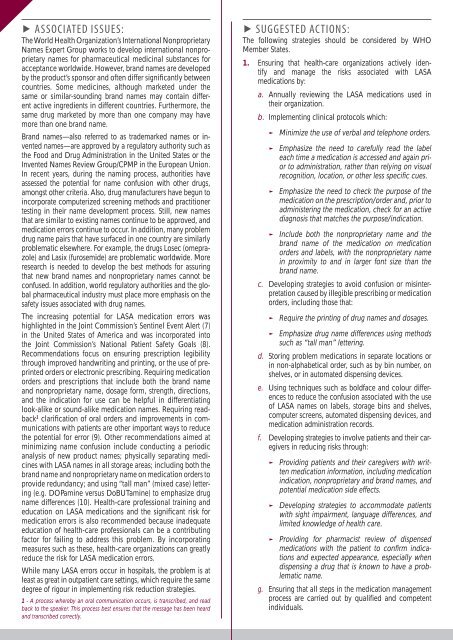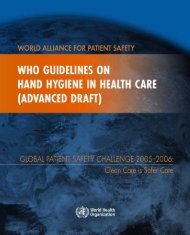Look-Alike, Sound-Alike Medication Names - World Health ...
Look-Alike, Sound-Alike Medication Names - World Health ...
Look-Alike, Sound-Alike Medication Names - World Health ...
You also want an ePaper? Increase the reach of your titles
YUMPU automatically turns print PDFs into web optimized ePapers that Google loves.
▶ ASSOCIATED ISSUES:<br />
The <strong>World</strong> <strong>Health</strong> Organization’s International Nonproprietary<br />
<strong>Names</strong> Expert Group works to develop international nonproprietary<br />
names for pharmaceutical medicinal substances for<br />
acceptance worldwide. However, brand names are developed<br />
by the product’s sponsor and often differ significantly between<br />
countries. Some medicines, although marketed under the<br />
same or similar-sounding brand names may contain different<br />
active ingredients in different countries. Furthermore, the<br />
same drug marketed by more than one company may have<br />
more than one brand name.<br />
Brand names—also referred to as trademarked names or invented<br />
names—are approved by a regulatory authority such as<br />
the Food and Drug Administration in the United States or the<br />
Invented <strong>Names</strong> Review Group/CPMP in the European Union.<br />
In recent years, during the naming process, authorities have<br />
assessed the potential for name confusion with other drugs,<br />
amongst other criteria. Also, drug manufacturers have begun to<br />
incorporate computerized screening methods and practitioner<br />
testing in their name development process. Still, new names<br />
that are similar to existing names continue to be approved, and<br />
medication errors continue to occur. In addition, many problem<br />
drug name pairs that have surfaced in one country are similarly<br />
problematic elsewhere. For example, the drugs Losec (omeprazole)<br />
and Lasix (furosemide) are problematic worldwide. More<br />
research is needed to develop the best methods for assuring<br />
that new brand names and nonproprietary names cannot be<br />
confused. In addition, world regulatory authorities and the global<br />
pharmaceutical industry must place more emphasis on the<br />
safety issues associated with drug names.<br />
The increasing potential for LASA medication errors was<br />
highlighted in the Joint Commission’s Sentinel Event Alert (7)<br />
in the United States of America and was incorporated into<br />
the Joint Commission’s National Patient Safety Goals (8).<br />
Recommendations focus on ensuring prescription legibility<br />
through improved handwriting and printing, or the use of preprinted<br />
orders or electronic prescribing. Requiring medication<br />
orders and prescriptions that include both the brand name<br />
and nonproprietary name, dosage form, strength, directions,<br />
and the indication for use can be helpful in differentiating<br />
look-alike or sound-alike medication names. Requiring readback<br />
1 clarification of oral orders and improvements in communications<br />
with patients are other important ways to reduce<br />
the potential for error (9). Other recommendations aimed at<br />
minimizing name confusion include conducting a periodic<br />
analysis of new product names; physically separating medicines<br />
with LASA names in all storage areas; including both the<br />
brand name and nonproprietary name on medication orders to<br />
provide redundancy; and using “tall man” (mixed case) lettering<br />
(e.g. DOPamine versus DoBUTamine) to emphasize drug<br />
name differences (10). <strong>Health</strong>-care professional training and<br />
education on LASA medications and the significant risk for<br />
medication errors is also recommended because inadequate<br />
education of health-care professionals can be a contributing<br />
factor for failing to address this problem. By incorporating<br />
measures such as these, health-care organizations can greatly<br />
reduce the risk for LASA medication errors.<br />
While many LASA errors occur in hospitals, the problem is at<br />
least as great in outpatient care settings, which require the same<br />
degree of rigour in implementing risk reduction strategies.<br />
1 - A process whereby an oral communication occurs, is transcribed, and read<br />
back to the speaker. This process best ensures that the message has been heard<br />
and transcribed correctly.<br />
▶<br />
SUGGESTED ACTIONS:<br />
The following strategies should be considered by WHO<br />
Member States.<br />
1. Ensuring that health-care organizations actively identify<br />
and manage the risks associated with LASA<br />
medications by:<br />
a. Annually reviewing the LASA medications used in<br />
their organization.<br />
b. Implementing clinical protocols which:<br />
►<br />
►<br />
►<br />
►<br />
Minimize the use of verbal and telephone orders.<br />
Emphasize the need to carefully read the label<br />
each time a medication is accessed and again prior<br />
to administration, rather than relying on visual<br />
recognition, location, or other less specific cues.<br />
Emphasize the need to check the purpose of the<br />
medication on the prescription/order and, prior to<br />
administering the medication, check for an active<br />
diagnosis that matches the purpose/indication.<br />
Include both the nonproprietary name and the<br />
brand name of the medication on medication<br />
orders and labels, with the nonproprietary name<br />
in proximity to and in larger font size than the<br />
brand name.<br />
c. Developing strategies to avoid confusion or misinterpretation<br />
caused by illegible prescribing or medication<br />
orders, including those that:<br />
►<br />
►<br />
Require the printing of drug names and dosages.<br />
Emphasize drug name differences using methods<br />
such as “tall man” lettering.<br />
d. Storing problem medications in separate locations or<br />
in non-alphabetical order, such as by bin number, on<br />
shelves, or in automated dispensing devices.<br />
e. Using techniques such as boldface and colour differences<br />
to reduce the confusion associated with the use<br />
of LASA names on labels, storage bins and shelves,<br />
computer screens, automated dispensing devices, and<br />
medication administration records.<br />
f. Developing strategies to involve patients and their caregivers<br />
in reducing risks through:<br />
►<br />
►<br />
►<br />
Providing patients and their caregivers with written<br />
medication information, including medication<br />
indication, nonproprietary and brand names, and<br />
potential medication side effects.<br />
Developing strategies to accommodate patients<br />
with sight impairment, language differences, and<br />
limited knowledge of health care.<br />
Providing for pharmacist review of dispensed<br />
medications with the patient to confirm indications<br />
and expected appearance, especially when<br />
dispensing a drug that is known to have a problematic<br />
name.<br />
g. Ensuring that all steps in the medication management<br />
process are carried out by qualified and competent<br />
individuals.
















